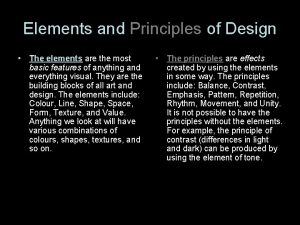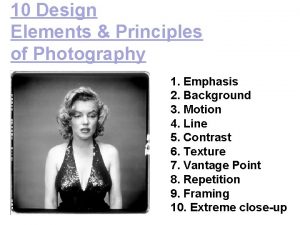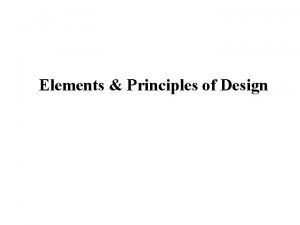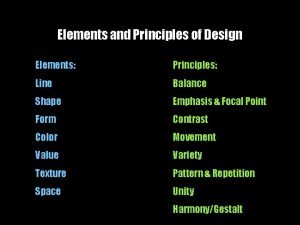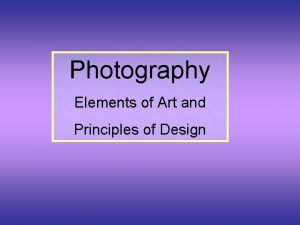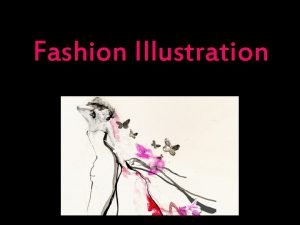PRINCIPLES OF DESIGN The elements of design line











































- Slides: 43

PRINCIPLES OF DESIGN

• The elements of design: line, shape, color, form, texture, space, motion, & value-must be organized in such a way to satisfy the artist’s expressive intent. • In two dimensional art this organization is called composition, but the more inclusive term, that applies to all kinds of art, is design. • The task of making the decisions involved in designing a work of art would be difficult were it not for certain guidelines that, once understood, become instinctive.

Principles of design. • These guidelines are usually known as the principles of design. • The principles of design are unity and variety, balance, emphasis and focal point, proportion and scale, rhythm.

Unity and variety Artist’s Goal Total Unity = Blandness Total Variety = Chaotic Unity: The sense of oneness, of things belonging together and making up a coherent whole. Variety: Differences that provide interest and contrast.

Unity and variety Ben Jones. Black faces and Arm Unit. 1971. Painted plaster, twelve life-size plaster casts.

Conceptual Unity: art unified through a unity of ideas.

Annette Messager. Mes Voeux. 1989. framed photographs and handwritten texts, suspended with twine; 59 x 15 ¾” • Conceptual unity asks for our interpretation. • Photos all portray different parts of the body • Repeated text within frames • Text and photos together as groupings represent different aspects of the human figure

• Conceptual Unity • • • Art unified by ideas instead of basic elements • Joseph Cornell – selected and arranged objects to create a conceptual unity that was meaningful to him based on his dreams, nostalgia, and fantasies. Joseph Cornell Untitled (Medici Princess). Mixed Media. c 1948.

Joseph Cornell. The Hotel Eden. 1945. Assemblage with music box, 15 1/8 x 4 3/8”

Extreme Unity and Variety Jackson Pollock. Shimmering Substance ( Sounds in the Grass series). 1946 Oil on canvas 30 1/8” x 24 ¼” • Jackson Pollock – • does away with • Traditional concerns of design • Nothing but unity and variety Drip Paintings

BALANCE Isamu Noguchi. Red Cube. 1968. Steel painted red. Marine Midland Bank, New York Visual Weight refers to the apparent “heaviness” or “lightness” of the forms arranged in a composition, as gauged by how insistently they draw our eyes. When visual weight is equally distributed to either side of a felt or implied center of gravity, you perceive that the composition is balanced. • Symmetrical Balance Near or exact matching of left and right sides of a three-dimensional form or • two-dimensional compositions • Asymmetrical Balance • not symmetrical – • composition has two sides that do not match.

Symmetrical Balance • With symmetrical balance, the implied center of gravity is the vertical axis, an imagery line drawn down the center of the composition. • Forms on either side of the axis match one another in size, shape, and placement. • Sometime it can so perfect both sides are mirror images. • Sometimes the images are very close but not exactly is called relieved symmetry.

Relieved Symmetry or Approximate Symmetry Georgia O’ Keefe. Deer’s Skull with Pedernal. 1936. Oil on canvas, 36 x 30”.

Newar artists at Densatil Monastery, Central Tibet. Thirteen. Deity Jnanadani Mandala. 1417 -47. opaque watercolor on cotton, cloth, 33 ½ x 28 7/8

The Luo Brothers. Welcome the World Famous Brand Name. Collage and lacquer on wood, 8 17/8” x 4 1 ½” x 1 1/16”

Approximate Symmetry or relieved Fridia Kahlo. The Two Fridas. 1939. Oil on canvas, 5’ 8 ½” square.

ASYMMETRICAL BALANCE • “Asymmetrical composition has two sides that do not match. • If it seems to be balanced, that is because the visual weights in the two halves are very similar. • “Heavy & light ?

Gustav Klimt. Death and Life. Before 1911, finished 1915. 5’ 10 x 6’ 6”

Joseph Mallory Turner; The Burning of the Houses of Parliament. C. 1835. Oil on canvas, 36 1/4 x 48 ½”

Edouard Manet. A Bar at the Folies-Bergere. 1881 -82. Oil on canvas, 37 ¾ x 51 ¼”

Balance Encourages our active participation in looking. Leads your eyes around the work, artists structure the experience. Helps to communicate a mood or meaning.

EMPHASIS AND SUBORDINATION • Emphasis and subordination are complementary concepts. • Emphasis means that your attention is drawn more to certain parts of a composition than to others. • Sometimes the emphasis is a small clearly defined area called a focal point. • Subordination means that some areas of the composition are purposely made less visually interesting, so that the areas of emphasis stand out.

Henry Ossawa Tanner. The Banjo Lesson. 1893. Oil on canvas, 49 x 35 ½”. Size and placement are used to emphasize figures largest form in painting. Focal point is circular body of banjo with boy’s hand on it Background subordinated so as not to interfere.

Francisco de Goya. Execution of the Third of May, 1808. 1814 -15. Oil on canvas, 8’ 9”x 13’ 4 ”.

SCALE AND PROPORTION Scale and proportion are related to size. • Scale means size in relation to a standard or “normal” size. • Both have to do with size • Scale - overall size • Scale, alone, can change the meaning of a work of art. • Proportion - relative size of objects within the work of art • Hierarchical Scale – the use of scale to indicate relative importance Mount Rushmore

Claes Oldenburg and Coosje van Bruggen. Plantoir, 2001. Stainless steel, aluminum, fiber-reinforced plastic, painted with polyurethane enamel, 23' 11" x 4' 5" x 4' 9". Collection Fundação de Serralves, Porto, Portugal.

Proportion Rene Magritte. Delusions of Grandeur II. 1948. Oil on canvas, 39 1/8”x 32 1/8”. René Magritte. Les Valeurs Personnelles (Personal Values). 1952

Proportion • Proportion refers to size relationships between parts of a whole, or between two or more items perceived as a unit. • Many cultures have developed a fixed set of proportions for depicting a “correct” or “perfect” human form. • Hierarchical scale is the representation of more important figures as larger than less important figures.

Many cultures developed fixed set of proportions for depicting “correct/perfect” human form • Egyptians • Squared grid • Palm of hand basic unit of measurement

Stela of the sculptor Userwer; detail. Eygpt, Dynasty 12, 1991 -1783 B. C. E.

A royal altar to the hand (ikegobo). Benin, 18 th century. Brass, height 18” Hierarchical Scale Use of unnatural proportions to show relative importance of figures • Proportions varied for symbolic or aesthetic purposes • Composition expresses social hierarchy • Indication of relative importance • King most important • Centrally located • Larger than attendants

El Greco. Resurrection. C. 1600 -05. Oil on canvas, 9’ ¼” x 4’ 2”.

Leonardo da Vinci. Study of Human Proportions according to Vitruvius. c. 1485 -90. Pen and ink, 13 ½ x 9 ¾”. “Numerical relationships held the key to beauty, and perfect human proportion reflected a divine order. ” • • • Da Vinci - one of many fascinated with ideas of Vitruvius (Roman Architect 1 st century BCE) • Vetruvius had treatise on architecture that was widely read during Renaissance • Related perfected male form to perfect geometry of square and circle • Figure stands inside square defined by his height and span of his arms • Circle centered at navel

Numerical Relationships A Golden Section • Greek and Roman idea revived by Renaissance artists Key to beauty and perfect human proportions Golden Section Ratio of two segments approx. 1 to 1. 618 Golden Rectangle constructed using proportions When square is cut off from one end remaining shape is also a Golden Rectangle Sequence that repeats itself infinitely and relates to such natural phenomena as spiraling outgrowth of a shell.


Le Corbusier, The Modulor, 1945, Fondation Le. © 2005 Artists Rights Corbusier Society (ARS), New York/ADAGP, Paris/FLC. Two overlapping golden sections.

Rhythm and Repetition Detail of The Hundred Geese. 1270 -1300. Ink on paper, Hand Scroll. 14 x 29” Rhythm – based on repetition that measures out the passing of time, organizing our experience of it. • Repetition of visual elements gives a composition unity, continuity, flow and emphasis

Lorna Simpson. Still from Easy to Remember. 2001. 16 mm film transferred to DVD, sound. 2: 35 minutes looped edition of 1, 1 AP. Courtesy: Sean Kelly Gallery, New York

Edward Hopper. Early Sunday morning. 1930. Oil on canvas, 2’ 11’ x 5’

Piet Mondrian. Broadway Boogie. Woogie. 1942 -43. Oil on canvas, 50 x 50”.

Rhythm Paul Klee. Landscape with Yellow Birds. 1923. Watercolor and gouache on paper, 13 7/8” x 17 ¼” Organized around several rhythms • Rhythm of tapered silvery forms • Implied oval made by small yellow birds • Implied arc of moon and red circles

Pablo Picasso. Girl Before a Mirror. 1932. Oil on canvas, 5’ 4” x 4’ 3 ¼”

Three Ages of the Woman and the Death 1510. oil on limewood, 18 7/8” x 12 ¾”
 A plain scale of 1 cm=5m and show on it 37m
A plain scale of 1 cm=5m and show on it 37m A hair form should be in proportion
A hair form should be in proportion Create length and height in hair design
Create length and height in hair design Transition in floral design
Transition in floral design Principles of design
Principles of design Elements of interior design ppt
Elements of interior design ppt Gradated rhythm
Gradated rhythm Elements of art and principles of design matrix
Elements of art and principles of design matrix Ci elements
Ci elements Elements and principles of design space
Elements and principles of design space 10 principles of photography
10 principles of photography Gradated rhythm
Gradated rhythm Elements and principles of landscape design
Elements and principles of landscape design What are the elements and principles of design
What are the elements and principles of design Christina's world
Christina's world Visual elements and principles of design
Visual elements and principles of design Elements and principles of photography
Elements and principles of photography Elements and principles of design fashion
Elements and principles of design fashion Hình ảnh bộ gõ cơ thể búng tay
Hình ảnh bộ gõ cơ thể búng tay Lp html
Lp html Bổ thể
Bổ thể Tỉ lệ cơ thể trẻ em
Tỉ lệ cơ thể trẻ em Chó sói
Chó sói Thang điểm glasgow
Thang điểm glasgow Hát lên người ơi alleluia
Hát lên người ơi alleluia Các môn thể thao bắt đầu bằng tiếng nhảy
Các môn thể thao bắt đầu bằng tiếng nhảy Thế nào là hệ số cao nhất
Thế nào là hệ số cao nhất Các châu lục và đại dương trên thế giới
Các châu lục và đại dương trên thế giới Công của trọng lực
Công của trọng lực Trời xanh đây là của chúng ta thể thơ
Trời xanh đây là của chúng ta thể thơ Mật thư anh em như thể tay chân
Mật thư anh em như thể tay chân 101012 bằng
101012 bằng Phản ứng thế ankan
Phản ứng thế ankan Các châu lục và đại dương trên thế giới
Các châu lục và đại dương trên thế giới Thể thơ truyền thống
Thể thơ truyền thống Quá trình desamine hóa có thể tạo ra
Quá trình desamine hóa có thể tạo ra Một số thể thơ truyền thống
Một số thể thơ truyền thống Cái miệng bé xinh thế chỉ nói điều hay thôi
Cái miệng bé xinh thế chỉ nói điều hay thôi Vẽ hình chiếu vuông góc của vật thể sau
Vẽ hình chiếu vuông góc của vật thể sau Nguyên nhân của sự mỏi cơ sinh 8
Nguyên nhân của sự mỏi cơ sinh 8 đặc điểm cơ thể của người tối cổ
đặc điểm cơ thể của người tối cổ Thế nào là giọng cùng tên
Thế nào là giọng cùng tên Vẽ hình chiếu đứng bằng cạnh của vật thể
Vẽ hình chiếu đứng bằng cạnh của vật thể Tia chieu sa te
Tia chieu sa te









